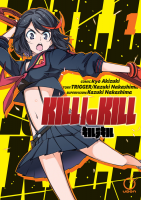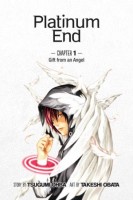Platinum End Volume 2 by Tsugumi Ohba and Takeshi Obata
This is a series that I want to like a little more than I actually do in practice after reading each volume. I thought that the first volume had a lot of potential, but I was a bit worried about some of the themes being a rehash of Death Note. I had a mixed experience with the second volume, finding the first few chapters more interesting than some of the main action depicted in the latter portion of the manga.
Mirai gets struck by a red arrow by a girl who he already had a crush on! This was the part of the manga that I found the most compelling as a reader, because Mirai has been dealing with manipulating people and the complications that ensue in the first volume, but then the situation is reversed in the second volume. This change of dynamic was interesting, and I thought the emotional aspects of being in thrall to someone were well-portrayed as Mirai is suddenly enthusiastic about protecting Saki at all costs, but he clearly would have been willing to help her without being coerced. Saki meanwhile seems to like him well enough but is still signaling her disinterest in a romantic relationship with Mirai in a diplomatic way.
The bulk of the manga deals with a confrontation with Metropoliman in a stadium, where a variety of coerced god-candidates and audience plants end up in a series of revelations and double-cross maneuverings that play out while Mirai and Saki have to sit in the stands like regular audience members, so they don’t end up being a target for the god candidates too. There wasn’t as much dramatic tension in these scenes because most of the time people were yelling variations of “gotcha!” and played out over multiple pages, it got to be a bit too one-note for me. I didn’t very much care for the way an under-aged girl with the god-power of wings was portrayed, with some of the panels like one showing the way she got struck by a red arrow are uncomfortably sexualized.
The art is always a highlight of any Obata title, and for the most part I’m enjoying that, but I’m hoping that the story ends up being a bit more compelling in future volumes. I’m still not finding this title as compelling as Death Note, but that’s a high bar to measure anything by. Although I’m not enjoying Platinum End as much as I hope to, it is still more interesting than many shonen titles.



